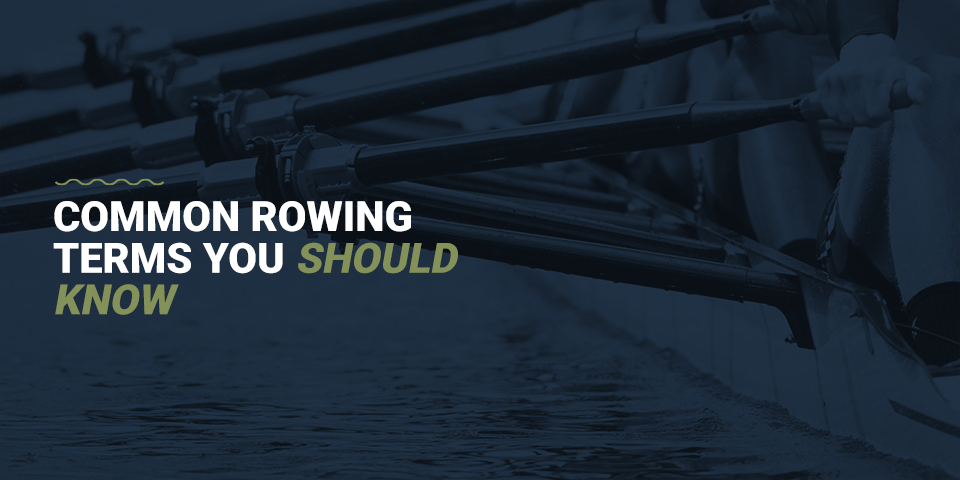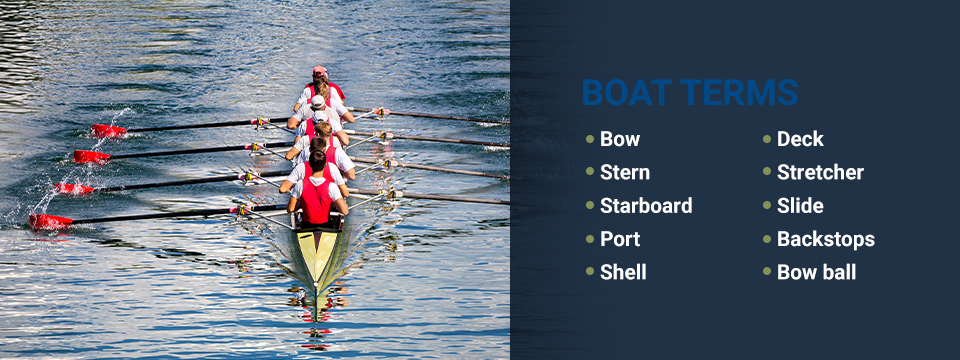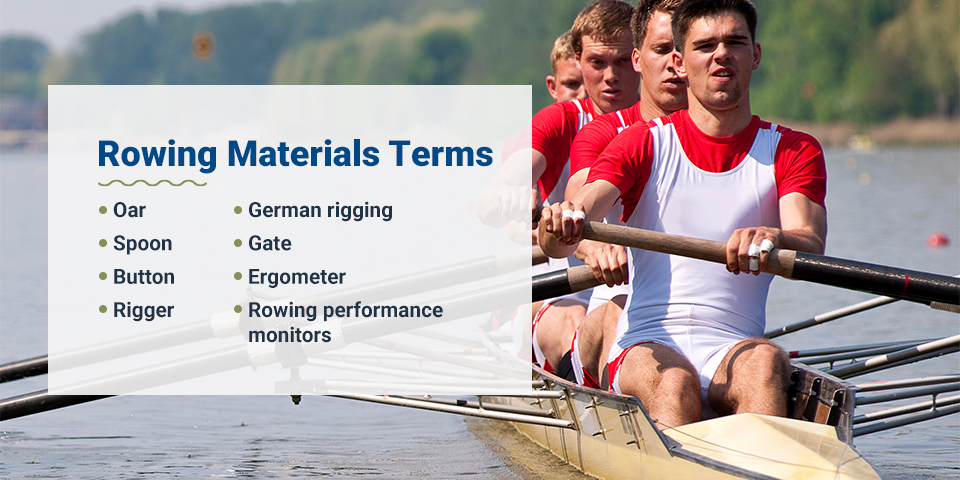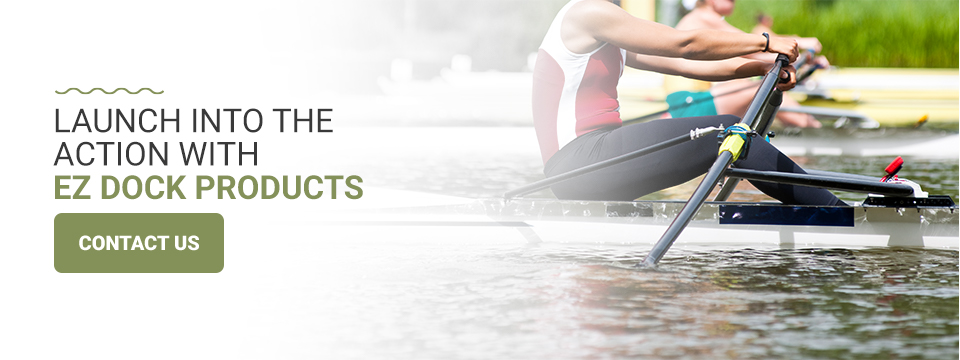Filters
Common Rowing Terms You Should Know
The sport of rowing demands hours of practice and time in the water. You’ll need teamwork and trust for your rowing team to achieve victory. And if you’re chasing after a record time, then you’ll have your work cut out for you. Get ready to spend lots of time in the water and keep your mind focused on reaching your goal — the first place prize.
To get the most from your rowing experience, you need to understand the terms. Knowing the rowing lingo will help you navigate getting into the sport. And if you’ve been at it a long time, then let this serve as a refresher course about the sport you love. Keep these common rowing terms in mind as you practice your rowing and strive to be one percent better every day.
Read the full article or jump to a specific section:
Boat Terms
Before getting into the actual rowing terms and definitions, you need to familiarize yourself with the boat. You’ll be spending hours in the boat, so you should know the names and purposes of all the essential components. Plus, knowing common boat terms will help you converse with your coaches and teammates. You’ll know what they’re talking about, which is especially important in the heat of the moment when you need to make adjustments.
Knowing the following terms will lay the foundation for everything to come as you progress in the sport of rowing:
- Bow: This is the front of the boat. It’s the sharpest part of the boat, able to slice through the water to give you faster forward movement. It’s also the first part of the boat to cross the finish line. This term can also refer to the rower who sits in the seat closest to the bow.
- Stern: The stern is the rear of the boat or the end opposite the bow. You and your teammates will be facing toward the stern as you row, so you’ll be seeing a lot of it during your time practicing and racing. The stern is the last part of the boat to cross the finish line.
- Starboard: Starboard refers to the right side of the boat when facing the bow.
- Port: Port refers to the left side of the boat when facing the bow. Having specific names for the right and left sides of the boat helps keep commands clear and followable for everyone in the boat. These terms also give viewers clarity as they observe the action.
- Shell: This is the smooth hull, or body, of the boat. Many people use this term as a synonym for “boat.” Many shells consist of wood, but modern boat makers have begun using synthetic materials or composites to create shells.
- Deck: A boat’s deck is the part that extends from bow to stern. It has a covering made of a thin plastic or fiberglass cloth for protection and durability.
- Stretcher: Also known as the foot-stretcher, this term refers to the area of the boat where the rowers place their feet. The stretcher has two inclined footrests bolted or screwed into place. You can adjust these screws to meet the individual needs of the rower. The stretcher’s material is typically either a metal or carbon plate.
- Slide: The slide consists of two metal runners on which the rowers’ seats attach. Each rower’s seat attaches to the slides with a set of wheels, allowing you to adjust the seats to the proper setting to meet the rower’s needs.
- Backstops: This term has two possible definitions. The first way to use this term is to describe the end of the slide nearest the bow. The backstop prevents the rowers’ seats from running off the slide. You can also use “backstop” to describe a rowing position where the rowers’ legs are straight and their oars are against their chest.
- Bow ball: The bow ball is a safety cap in the shape of a ball that covers the bow end of the boat. This is a required safety item for every rowboat. The bow ball protects other athletes on the water in the event of a collision. The tip of the bow is a pointed structure that could be harmful, so the bow ball makes them safer if an accident occurs.
Rowing Materials Terms
Rowing uses specific terms to describe the materials used throughout the sport. These materials are essential to the sport, giving rowers and coaches the framework for communicating and putting their knowledge to action. Some of these materials can even help rowers improve by providing real-time metrics and stats. Other materials are tools that rowers use to perform their techniques.
Look at the following list of rowing materials and terms for a better understanding of what sets the sport of rowing apart from other water sports:
- Oar: Rowers use oars to drive the boat forward. We’ll take a closer look at the techniques rowers use with oars in the next section. Remember that rowers do not use paddles, which are different items than oars. For now, know that oars propel the boat forward by dipping into and pushing against the water. Some rowers refer to the oars as “blades.”
- Spoon: The spoon is the section of the oar that enters the water. Teams often paint the spoons of the oars with their team colors to show team spirit and help viewers identify them during the race.
- Button: Every oar contains a wide collar, or button, on the shaft that stops the oar from slipping through the swivel of the rigger system. The button keeps oars in the boats, even when a rower loses their grip during rowing.
- Rigger: The rigger is the triangular metal piece bolted to the boat’s shell next to each rowing seat which alternates in position all the way down. Riggers contain a pin and a swivel, which provide the means for securing the rowers’ oars as they push through the water. Most riggers consist of either carbon or metal tubing. Rowers rely on riggers to set their oars so they can focus on their techniques. Otherwise, their oars would be resting loosely on the shell, making powerful, precise rowing techniques difficult.
- German rigging: A German rigging setup places riggers on the same sides of the boat for two consecutive rowers. This is different from the standard rigger layout, which uses alternating riggers for each rower.
- Gate: The gate is a small bar that goes across the oarlock on the riggers. Gates ensure the oars stay on the riggers, giving rowers the security they need for their techniques during races and practices.
- Ergometer: An ergometer is an exercise machine that simulates the rowing motion for rowers to use to track their strokes per minute and distance traveled. It’s a good way to practice rowing techniques without having to take a boat onto the water. It’s also useful for pushing your limits and seeing how much you can improve over time, helping you achieve more stamina when taking out the boat. Rowers refer to this machine as an “erg” for short.
- Rowing performance monitors: Various performance monitors exist for rowers to use to track important race metrics. These can include stroke and the elapsed time since the start of the race. Different options are available from companies that specialize in these types of devices. They attach right onto the boat, making them easy to use and helpful for every rower in the boat.
Rowing Techniques Terms
Rowing consists of more than several individuals rowing however they feel in the moment. You’ll need a high level of technique if you want to have success on the water. You’ll also need to know about the different roles of people on the boat, as each role is essential to the team’s performance. Only with proper teamwork and the right techniques will you and your team achieve success and experience the joy of competitive rowing.
Read the following list to learn more about the various rowing techniques and terms for describing aspects of the rowing process:
- Coxswain: The coxswain, or cox, steers the boat by controlling wires or strings attached to the boat’s rudder. They usually sit in the stern section of the boat. The coxswain also serves as the on-the-water coach for the rowers, instructing them and giving them real-time commands and updates.
- Bow coxed boat: This type of rowing configuration puts the coxswain in the bow of the boat instead of the stern. The coxswain will lie down in the bow, only peeking their head over the edge of the shell. This position reduces wind resistance and offers better weight distribution, aiding the rowers’ forward progression.
- Stroke: This term can refer to two aspects of the rowing process. The first definition refers to a single, complete rowing motion, or rowing cycle. A full stroke consists of the “catch,” the “length” and the “finish.” “Stroke” is also describes the rower sitting closest to the stern during rowing activities. The stroke will set the rhythm, or cadence, of the rowing pattern. The rowers behind the stroke will follow their lead to match the same rhythm.
- Catch: The catch, or beginning of a stroke, describes the moment when the spoon enters the water during the stroke. This is the exact moment when rowers will apply propulsive force to the oar to push the boat forward.
- Length: A stroke’s length describes the arc the spoon takes when it is in the water after the catch.
- Extraction: The extraction is the part of the stroke when a rower applies downward force to the oar handle to remove the spoon from the water. This part of the stroke is easiest when the rowers apply force through the water until the last moment, leading right into a successful extraction.
- Recovery: The time when the oar’s spoon is out of the water from extraction and moving to the next cycle’s catch is the recovery period.
- Finish: The finish is the final part of a full stroke. The finish is the moment when the rowers pull the oar handle toward themselves. At the moment immediately following a successful finish, the boat will be at its highest speed. From here, the rowers can engage in another stroke, making sure to time it for a maximum continuous speed.
- Straight: A straight is a shell or boat without room for a coxswain. Many people refer to straights as “straight fours,” “straight pairs” or “coxless boats.”
- Run: The distance traveled by the shell during a single stroke of the oars is the run. You can get an accurate idea of the length of a rowing team’s run by observing the space between two areas of ripples in the water made by the same oar. These rippled areas are where the oar entered the water, showing you how far a single push of the oar sent the boat.
- Lightweight: This is a weight class used to describe the weight of the rowers within a given boat. In a lightweight rowing match, each rower must stay under a determined weight. The combined weight of all rowers must also stay under a certain number so they can participate in the lightweight competition.
- Power 10: The coxswain could call for the rowers to perform a “power 10” at any point of a rowing competition. This rowing technique calls for the rowers to give 10 of their most powerful strokes while maintaining their unified rhythm. Ten individual powerful strokes would do more harm than good, so maintaining a rhythm with the additional power is key. Rowers will break into a power 10 to pull ahead of a nearby competitor.
- Scull: A scull is a smaller version of an oar used in the activity of sculling.
- Sculling: This is an alternative version of rowing where rowers use sculls to propel the boat through the water. Each sculler uses two sculls, one in each hand. This is in stark contrast to standard rowing competitions where each rower handles a single oar.
- Swing: Swing refers to the magic moment that occurs among rowers when they reach near-perfect synchronization during rowing exercises and races. It’s hard to define the exact moment when full swing happens, but when you feel it, you’ll know. Swing is the best zone to be in, as you know you and your teammates are operating at your peak potential for that moment.
Launch Into the Action With EZ Dock Products
At EZ Dock, we’ve been making high-quality, low-profile boating docks since 1991. We construct our floating docks with polyethylene to make them slip-resistant and splinter-free. This material provides an enjoyable, comfortable experience near the water, even with bare feet. Wood breaks down over time, but our docks last for years. In fact, the first dock we ever installed is still in use today. You know you’re making a great investment when you choose rowing docks from EZ Dock for your rowing team.
Contact us online today for more information about how we can enhance your enjoyment of the water and the sport of rowing. We look forward to serving you and helping you improve in your rowing journey.














